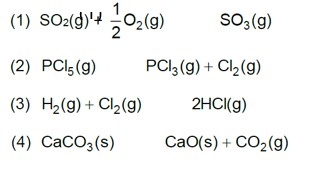The ionisation constant of an acid, Ka , is the measure of strength of an acid. The Ka values of acetic acid, hypochlorous acid and formic acid are 1.74 × 10–5, 3.0 × 10–8 and 1.8 × 10–4 respectively. Which of the following orders of pH of 0.1 mol dm–3 solutions of these acids is correct?
(i) Acetic acid > hypochlorous acid > formic acid
(ii) Hypochlorous acid > acetic acid > formic acid
(iii) Formic acid > hypochlorous acid > acetic acid
(iv) Formic acid > acetic acid > hypochlorous acid
The ionisation constant of an acid, Ka , is the measure of strength of an acid. The Ka values of acetic acid, hypochlorous acid and formic acid are 1.74 × 10–5, 3.0 × 10–8 and 1.8 × 10–4 respectively. Which of the following orders of pH of 0.1 mol dm–3 solutions of these acids is correct?
(i) Acetic acid > hypochlorous acid > formic acid
(ii) Hypochlorous acid > acetic acid > formic acid
(iii) Formic acid > hypochlorous acid > acetic acid
(iv) Formic acid > acetic acid > hypochlorous acid
-
1 Answer
-
This is a Multiple Choice Questions as classified in NCERT Exemplar
Ans: option (iv)
Higher the value of Ka higher will be the acidic strength Ka value for formic acid is the highest and that will be of hypochlorous acid is the lowest.
Similar Questions for you
0.01 M NaOH,
M = 1 * 10-2

pOH = 2
pH = 2
Kp = Kc (RT)Dng
36 * 10–2 = Kc (0.0821 * 300)–1
Kc = 0.36 * 0.0821 * 300 = 8.86 » 9
A(g) ->B(g) + (g)
Initial moles n 0 0
Eqb. moles n(1 – a) na
total moles =
Eqb. pressure
On increasing pressure, equilibrium moves in that direction where number of gaseous moles decreases.
Taking an Exam? Selecting a College?
Get authentic answers from experts, students and alumni that you won't find anywhere else
Sign Up on ShikshaOn Shiksha, get access to
- 65k Colleges
- 1.2k Exams
- 679k Reviews
- 1800k Answers


